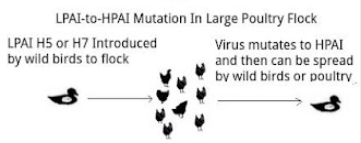#18,102
Roughly 2 weeks ago Agriculture Victoria announced Two Outbreaks of H7N3 In Victoria, on farms located roughly 70 miles apart (Meredith and Terang). Yesterday a 3rd farm (in Meredith) was announced as infected, and today a 4th farm (also in Meredith) has been added.
While their agricultural website has been somewhat parsimonious with the details, media sources suggest the number of birds culled is approaching 600,000.
Today's update follows, after which I'll have a bit more on Australia's lack of H5N1.
Unlike the rest of the world, Australia, NZ, and Oceania have been spared any impact from HPAI H5N1, despite lying beneath both the West Pacific and East Asian–Australasian Flyway (see map below).

Importantly for avian flu, very few migratory birds appear to cross the Wallace line (see The Australo-Papuan bird migration system: another consequence of Wallace's Line).
Current situation
Last updated 05 Jun 2024 2:50pm
We are responding to the detection of avian influenza at 4 Victorian poultry farms.
Three infected properties near Meredith are confirmed to have the high pathogenicity H7N3 strain of avian influenza, and the infected property near Terang is confirmed to have the high pathogenicity H7N9 strain.
Three of the infected properties are located in the Restricted and Control Areas in Meredith and Lethbridge, in the Golden Plains Shire and one is in the Corangamite Shire where movement restrictions were already in place.
All properties have been placed in quarantine and all poultry will be safely disposed of. The sites will be cleaned and cleared of the infection
Housing requirement
We have issued movement controls that include a housing requirement for all birds within the Restricted Areas and Control Areas in Meredith and Terang.
Under the housing requirement all poultry farmers, backyard flock and bird owners must house or keep their birds enclosed in cages or sheds as much as practical.
Agriculture Victoria staff are on the ground supporting the businesses and working closely with industry to contain and eradicate the virus. Contact tracing is also underway to determine the source and spread of the infection.
Avian influenza is a viral disease of birds found globally. Virus strains are described as low pathogenicity (LPAI) or high pathogenicity (HPAI).
Poultry farmers, backyard flock and bird owners are urged to report any cases of unexplained bird deaths to the VicEmergency Hotline on 1800 226 226.
While cases among humans in direct contact with animals infected with highly pathogenic avian influenza viruses are possible, the current risk to the public remains low. Find out more about avian influenza in humans from the BetterHealth Channel.
Movement controls
Movement controls are now in place to prevent any spread of avian influenza.
This includes:
The movement controls require permits for the movement of birds, poultry products, feed and equipment on or off the properties in these areas. Penalties apply for those who do not follow these restrictions.
- a Restricted Area that covers the impacted Meredith and Lethbridge properties and a broader Control Area buffer zone, which is bound by Bacchus Marsh Road in the east and the Colac–Ballarat Road on the western boundary are in place.
- a Restricted Area covering a 5 km radius around the Terang farm with a broader Control Area buffer zone covering a 15 km radius
- a housing requirement for all birds within these areas.
Examples of products that can't be moved without a permit include eggs, poultry feed, drinking water and bedding.
Unlike the rest of the world, Australia, NZ, and Oceania have been spared any impact from HPAI H5N1, despite lying beneath both the West Pacific and East Asian–Australasian Flyway (see map below).

This good fortune has often been attributed to the Wallace and Weber lines; imaginary dividing lines used to mark the difference between animal species found in Australia and Papua New Guinea and the rest of Southeast Asia (see 2008 study Will Wallace’s Line Save Australia from Avian Influenza?).
On the western side you'll find Elephants, monkeys, leopards, tigers, and water buffalo while on the eastern side, you'll mostly find marsupials (kangaroos, Koalas, wombats, etc.).
These stark faunal differences also extend to birds, reptiles, and even insects.
Importantly for avian flu, very few migratory birds appear to cross the Wallace line (see The Australo-Papuan bird migration system: another consequence of Wallace's Line).
But the introduction of H5N1 to Antarctica provides the virus with a potential southern route that could circumvent the Wallace and Weber lines.
Last December OFFLU warned:
While the that avenue may currently seem like a long-shot, HPAI H5's global field experiment continues, and there appears to be little we can do to stop it.Given movement data demonstrating connectivity between the polar front to both the Antarctic and Subantarctic islands of Oceania, and Oceania itself, it is plausible that if HPAI H5 were present in the Antarctic region directly south of Oceania, it could be introduced to Oceania.



